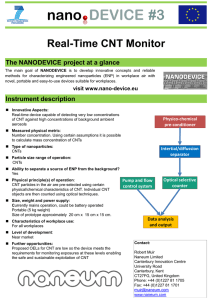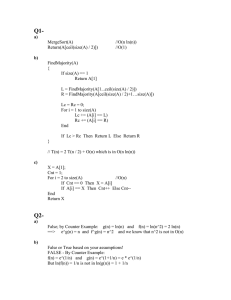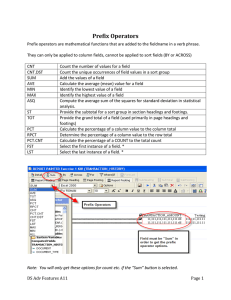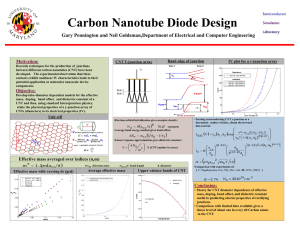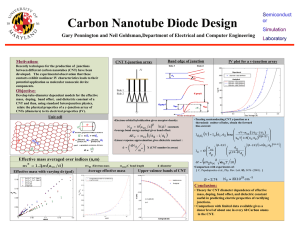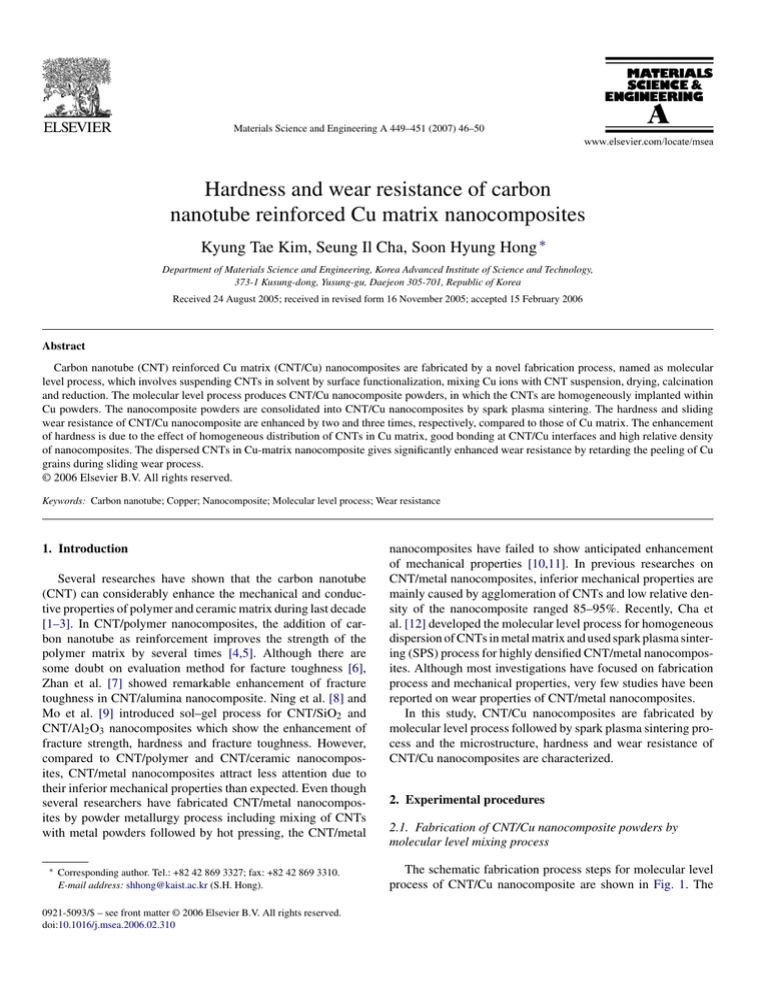
Materials Science and Engineering A 449–451 (2007) 46–50
Hardness and wear resistance of carbon
nanotube reinforced Cu matrix nanocomposites
Kyung Tae Kim, Seung Il Cha, Soon Hyung Hong ∗
Department of Materials Science and Engineering, Korea Advanced Institute of Science and Technology,
373-1 Kusung-dong, Yusung-gu, Daejeon 305-701, Republic of Korea
Received 24 August 2005; received in revised form 16 November 2005; accepted 15 February 2006
Abstract
Carbon nanotube (CNT) reinforced Cu matrix (CNT/Cu) nanocomposites are fabricated by a novel fabrication process, named as molecular
level process, which involves suspending CNTs in solvent by surface functionalization, mixing Cu ions with CNT suspension, drying, calcination
and reduction. The molecular level process produces CNT/Cu nanocomposite powders, in which the CNTs are homogeneously implanted within
Cu powders. The nanocomposite powders are consolidated into CNT/Cu nanocomposites by spark plasma sintering. The hardness and sliding
wear resistance of CNT/Cu nanocomposite are enhanced by two and three times, respectively, compared to those of Cu matrix. The enhancement
of hardness is due to the effect of homogeneous distribution of CNTs in Cu matrix, good bonding at CNT/Cu interfaces and high relative density
of nanocomposites. The dispersed CNTs in Cu-matrix nanocomposite gives significantly enhanced wear resistance by retarding the peeling of Cu
grains during sliding wear process.
© 2006 Elsevier B.V. All rights reserved.
Keywords: Carbon nanotube; Copper; Nanocomposite; Molecular level process; Wear resistance
1. Introduction
Several researches have shown that the carbon nanotube
(CNT) can considerably enhance the mechanical and conductive properties of polymer and ceramic matrix during last decade
[1–3]. In CNT/polymer nanocomposites, the addition of carbon nanotube as reinforcement improves the strength of the
polymer matrix by several times [4,5]. Although there are
some doubt on evaluation method for facture toughness [6],
Zhan et al. [7] showed remarkable enhancement of fracture
toughness in CNT/alumina nanocomposite. Ning et al. [8] and
Mo et al. [9] introduced sol–gel process for CNT/SiO2 and
CNT/Al2 O3 nanocomposites which show the enhancement of
fracture strength, hardness and fracture toughness. However,
compared to CNT/polymer and CNT/ceramic nanocomposites, CNT/metal nanocomposites attract less attention due to
their inferior mechanical properties than expected. Even though
several researchers have fabricated CNT/metal nanocomposites by powder metallurgy process including mixing of CNTs
with metal powders followed by hot pressing, the CNT/metal
∗
Corresponding author. Tel.: +82 42 869 3327; fax: +82 42 869 3310.
E-mail address: shhong@kaist.ac.kr (S.H. Hong).
0921-5093/$ – see front matter © 2006 Elsevier B.V. All rights reserved.
doi:10.1016/j.msea.2006.02.310
nanocomposites have failed to show anticipated enhancement
of mechanical properties [10,11]. In previous researches on
CNT/metal nanocomposites, inferior mechanical properties are
mainly caused by agglomeration of CNTs and low relative density of the nanocomposite ranged 85–95%. Recently, Cha et
al. [12] developed the molecular level process for homogeneous
dispersion of CNTs in metal matrix and used spark plasma sintering (SPS) process for highly densified CNT/metal nanocomposites. Although most investigations have focused on fabrication
process and mechanical properties, very few studies have been
reported on wear properties of CNT/metal nanocomposites.
In this study, CNT/Cu nanocomposites are fabricated by
molecular level process followed by spark plasma sintering process and the microstructure, hardness and wear resistance of
CNT/Cu nanocomposites are characterized.
2. Experimental procedures
2.1. Fabrication of CNT/Cu nanocomposite powders by
molecular level mixing process
The schematic fabrication process steps for molecular level
process of CNT/Cu nanocomposite are shown in Fig. 1. The
K.T. Kim et al. / Materials Science and Engineering A 449–451 (2007) 46–50
47
height. Microstructure characterization of CNT/Cu nanocomposites was carried out using high-resolution scanning electron
microscopy (HRSEM) and transmission electron microscopy
(TEM). The volume fraction of CNTs was determined by analyzing the carbon contents using an Elemental Analyzer (EA1110FISONS) and a C/S analyzer (ELTRA CS800). Vickers hardness tests were performed to evaluate the hardness of CNT/Cu
nanocomposites. Pin-on-disk type wear tests were performed to
evaluate the wear resistance under dry sliding condition [18].
The wear tests were carried out at a sliding speed of 150 rpm, at
applied load 30 N and rotating distance of 1 km using a rotating
disk made by SKD 61 tool steel.
3. Results and discussion
The nanocomposite powders fabricated by the molecular
level process gives homogeneously dispersed CNTs within Cu
powders as shown in Fig. 2. The most important feature of this
process is mixing CNTs with Cu ions in molecular level. That is,
the CNTs are embedded or implanted within Cu powders rather
than attached on the surface of Cu powders. The morphologies
Fig. 1. Schematic fabrication process steps for molecular level process of
CNT/Cu nanocomposites.
fabrication process for CNT/Cu nanocomposite powders consists of four steps [12]. As the first step, multi-wall carbon
nanotubes (MWCNTs), with diameter of 10–40 nm and with
length of a few micrometers, were purified and functionalized
by acid treatment. There are several chemical methods for attaching functional groups on the CNT surfaces [13–16]. Once the
functional groups are attached on the CNTs, the electrostatic
repulsive force between CNTs overcomes the Van der Waals
force to form a homogeneous suspension within a solvent. In second step, Cu acetate monohydrate [Cu(CH3 COO)2 ·H2 O] was
added to the CNT suspension and sonicated for 2 h then the
CNT/Cu ion precursor was fabricated. In third step, the solution
of CNT/Cu ion precursor was vaporized with magnetic stirring at
100 ◦ C, and the vaporized CNT/Cu ion precursor powders were
calcinated into CNT/CuO nanocomposite powders at 350 ◦ C in
air. Finally the CNT/CuO composite powders were reduced into
CNT/Cu nanocomposite powders under hydrogen atmosphere.
2.2. Consolidation and characterization of CNT/Cu
nanocomposite powders
The fabricated CNT/Cu nanocomposite powders were consolidated by spark plasma sintering, which enables the powders
to be sintered by Joule heat and spark plasma generated by
high pulsed electric current applied through the compact [17].
The CNT/Cu nanocomposite powders were sintered at 550 ◦ C
for 1 min in a vacuum of 10−3 mbar with an applied pressure
of 50 MPa. The heating rate up to the sintering temperature
was maintained at 100 K/min. The sintered CNT/Cu nanocomposite has the cylindrical shape of 15 mm diameter and 3 mm
Fig. 2. Microstructures of composite powders, in which the carbon nanotubes
are homogeneously implanted in the matrix. (a) SEM micrographs of CNT/CuO
composite powders obtained after calcination and (b) SEM images of CNT/Cu
composite powders obtained after reduction.
48
K.T. Kim et al. / Materials Science and Engineering A 449–451 (2007) 46–50
Table 1
Relative densities of CNT/Cu nanocomposites with vol.% of CNTs
Volume percent of CNT (%)
Measured density (g/cm3 )
Theoretical density (g/cm3 )
Relative density (%)
0
5
10
8.79
8.45
8.08
8.90
8.53
8.17
99.2
99.0
98.9
of the CNT/CuO and CNT/Cu nanocomposite powders show
an ideal composite microstructure, which displays morphologies of CNTs implanted in the powders (Fig. 2(a) and (b)). The
fabricated CNT/Cu nanocomposite powders are consolidated
into bulk CNT/Cu nanocomposite with full densification (above
99%) as shown in Table 1 by spark plasma sintering process.
The photos of consolidated pure Cu and CNT/Cu nanocomposite
specimens are displayed in Fig. 3(a) and the surface morphology
of etched 5 vol.% CNT/Cu nanocomposite is shown in Fig. 3(b).
The microstructure of consolidated CNT/Cu nanocomposites
shows homogeneous distribution of carbon nanotubes within the
Cu matrix. Particularly, the TEM images (Fig. 3(c)) shows that
the carbon nanotubes form a three-dimensional network within
Cu grain.
The hardness of the CNT/Cu nanocomposites measured by
Vickers hardness test is shown in Fig. 4(a). A considerable
enhancement of hardness is observed by addition of CNTs in
Fig. 3. (a) The consolidated pure Cu and CNT/Cu nanocomposites obtained after
spark plasma sintering process, (b) SEM images showing homogeneous distribution of carbon nanotubes, which are revealed after chemical etching of 5 vol.%
CNT/Cu nanocomposite and (c) TEM images showing three-dimensional network of CNTs in Cu grain.
Fig. 4. (a) The variation of Vickers hardness of CNT/Cu nanocomposites with
varying the volume fraction of carbon nanotubes and (b) the variation of wear
properties of CNT/Cu nanocomposites with varying the volume fraction of carbon nanotubes.
K.T. Kim et al. / Materials Science and Engineering A 449–451 (2007) 46–50
49
Fig. 5. (a) SEM images of worn surface of pure Cu, (b) schematic figure indicating the worn surface of pure Cu, (c) SEM images of worn surface of CNT/Cu
nanocomposite and (d) schematic figure indicating the worn surface of CNT/Cu nanocomposite.
Cu matrix. The hardness increases almost linearly with increasing the CNT volume fraction up to 10%. When the 10 vol.%
of CNTs are reinforced, the hardness of CNT/Cu nanocomposites is 1.1 GPa, which is about 1.8 times higher than that of
Cu without CNTs. In previous researches, when the CNT/metal
or CNT/ceramic nanocomposites are fabricated by molecular level process, the chemical bonding formed between the
CNTs and the matrix ions provides homogeneous distribution
of CNTs as well as high interfacial strength [12,19]. Therefore, it is confirmed that such remarkable enhancement of
hardness by CNT reinforcement is originated from the high
interfacial strength at CNT/Cu interface, the homogeneous distribution of CNTs within Cu matrix and attained high relative densities. Thus, based on this result, it can be shown that
the improvement of mechanical properties of CNT reinforced
nanocomposites is expected when the external load can be
shared by homogeneously distributed CNTs through the load
transfer from matrix to CNTs by sound interfacial strength at
CNT/matrix.
Fig. 4(b) shows the wear loss and wear rate of CNT/Cu
nanocomposites evaluated by pin-on-disk wear test. Under dry
sliding wear condition, the wear loss of CNT/Cu nanocomposites is reduced to 1/3 compared to those of pure Cu matrix.
This result means that this nanocomposite shows three times
higher wear resistance by addition of CNTs. The microstructures
of the worn surface of pure Cu and CNT/Cu nanocomposite were shown in Fig. 5(a) and (c). The worn surface of the
CNT/Cu nanocomposite shows almost clear surface morphology
as shown in Fig. 5(c), while that of the pure Cu shows flaked
microstructure as shown in Fig. 5(a).
When the surface of pure Cu flakes away during the wear
process, the worn chips are formed by peeling of Cu grains
(Fig. 5(b)) near the worn surface. However, in case of CNT/Cu
nanocomposite, the Cu grains are not easily peeled from the
worn surface by the pinning of homogeneously implanted CNTs
across Cu grains as observed in TEM images (Fig. 5(d)) of
CNT/Cu nanocomposites. At the same time, the CNTs exposed
to the worn surface during wear process can act as a lubricating
carbon film owing to its low friction coefficient [10]. Therefore, the wear loss of CNT/Cu nanocomposites is remarkably
decreased with increasing volume fraction of CNTs due to the
effect of homogeneous distribution of CNTs in Cu matrix and
low friction coefficient of exposed CNTs on the worn surface.
4. Conclusion
The CNT/Cu nanocomposite with homogeneously dispersed
CNTs within Cu matrix can be fabricated by means of a novel
process named as the molecular level process. The hardness
and wear resistance of fabricated CNT/Cu nanocomposite were
significantly increased with increasing the volume fraction of
CNTs. The remarkable enhancement of hardness is originated
from the homogeneously distributed CNTs in Cu matrix, high
interfacial strength at CNT/Cu interfaces and high relative density of nanocomposites. The dispersed CNTs in Cu-matrix
nanocomposite provides considerably enhanced wear resistance
50
K.T. Kim et al. / Materials Science and Engineering A 449–451 (2007) 46–50
by retarding the peeling of Cu grains during sliding wear process. It is concluded that the homogeneous distribution of CNTs
with sound interface in Cu matrix is an important technological
issue to enhance the mechanical behavior and wear resistance
of CNT/Cu nanocomposite.
Acknowledgement
This research was supported by a grant (code #: 06K150100510) from ‘Center for Nanostructured Materials Technology’
under ‘21st Century Frontier R&D Programs’ of the Ministry of
Science and Technology, Korea.
References
[1] Y. Zhang, N.W. Franklin, R.J. Chen, H. Dai, Chem. Phys. Lett. 331 (2000)
35–41.
[2] K.T. Lau, D. Hui, Carbon 40 (2002) 1597–1617.
[3] H. Dai, Surf. Sci. 500 (2002) 218–241.
[4] E.T. Thostenson, Z. Ren, T.W. Chou, Compos. Sci. Technol. 61 (2001)
1899–1912.
[5] C.L. Xu, B.Q. Wei, R.Z. Ma, J. Liang, S.K. Ma, D.H. Wu, Carbon 37 (1999)
855–858.
[6] X. Wang, N.P. Padture, H. Tanaka, Nat. Mater. 3 (2004) 539–544.
[7] G.D. Zhan, J.D. Kuntz, J. Wan, A.K. Mukherjee, Nat. Mater. 2 (2003)
38–42.
[8] J. Ning, J. Zhang, Y. Pan, J. Guo, Mater. Sci. Eng. A 357 (2003) 392–
396.
[9] C.B. Mo, S.I. Cha, K.T. Kim, K.H. Lee, S.H. Hong, Mater. Sci. Eng. A 395
(2005) 124–128.
[10] S.R. Dong, J.P. Tu, X.B. Zhang, Mater. Sci. Eng. A 313 (2001) 83–87.
[11] X. Chen, J. Xia, J. Peng, W. Li, S. Xie, Compos. Sci. Technol. 60 (2000)
301–306.
[12] S.I. Cha, K.T. Kim, S.N. Arshad, C.B. Mo, S.H. Hong, Adv. Mater. 17
(2005) 1377–1381.
[13] J. Liu, et al., Science 280 (1998) 1253–1256.
[14] M.A. Hamon, et al., Adv. Mater. 11 (1999) 834–840.
[15] R. Bandyopadhyaya, E. Nativ-Roth, O. Regev, R. Yerushalmi-Rozen, Nano
Lett. 2 (2002) 25–28.
[16] W. Huan, et al., Nano Lett. 2 (2002) 231–234.
[17] M. Omori, Mater. Sci. Eng. A 287 (2000) 183–188.
[18] J.K. Kim, P.K. Rohatgi, J.O. Choi, C.O. Choi, Mat. Mater. Int. 11 (4) (2005)
333–340.
[19] S.I. Cha, K.T. Kim, K.H. Lee, C.B. Mo, S.H. Hong, Scripta Mater. 53
(2005) 793–797.

